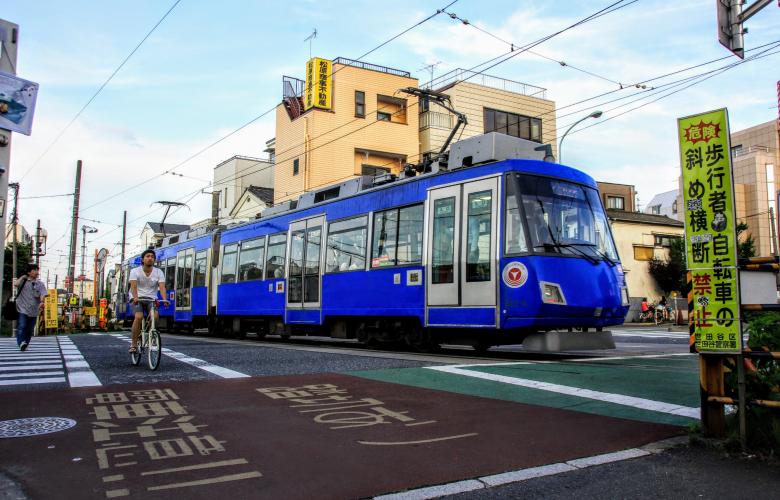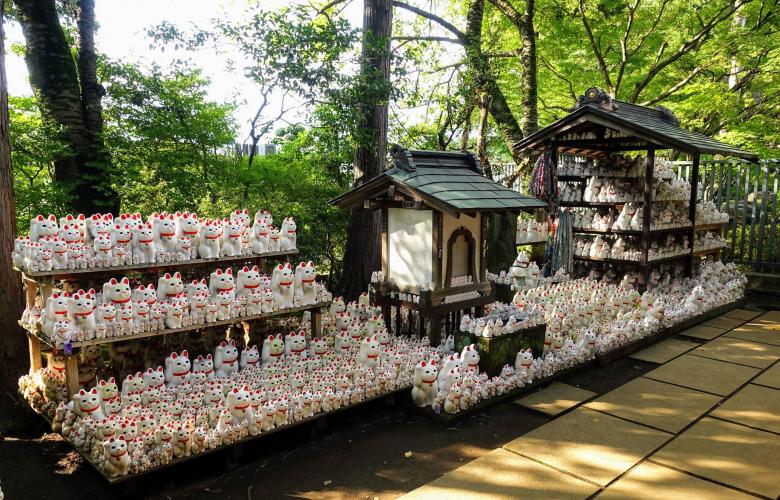A small line most people have never heard of, the Setagaya Line is a tram line stretching a mere 5km with just 10 stops, many of which are unmanned. Originally opened in 1923 by Tamagawa Electric Railway, known as Tamaden, it connected Shibuya with the Tama River. Following a merger with Tokyu in 1938 and a shortening of the line in 1969, it is now one of only two tramways in Tokyo (three if you include the Enoden which is in Greater Tokyo). If you need to be close to the big stations for work but hate living in towering apartment blocks, this is the option for you.
1. So. Many. Trams.
Although you might think such a small line would be annoyingly infrequent, the Setagaya Line is almost the opposite. Forget checking train times, it's easier to simply show up as they pass every six minutes like clockwork. Not only that, they start early — leaving Sangenjaya at 5:15am and Shimo-Takaido a couple of minutes earlier. For nights out you can catch the last train at 12:35am from Sangenjaya or 12:15am from Nishi-Takaido — leaving you with no excuse for not having that final drink.
As an extra treat, you'll sometimes be lucky enough to catch the cat-themed tram — a celebration of the Gotokuji Temple cat, it can put a smile on your face on even the most depressing of Monday mornings.
2. Commuting connections
It may be little, but the Setagaya Line can be a great way to connect to larger lines while still beating the rush. There are three spots for connections, each offering a different line.
At one end, Shimo-Takaido offers a brisk walk to the Keio Line which will whisk you off to Shinjuku in just eleven minutes (nine if you care to switch to express services at Meidaimae).
In the other direction, Sangenjaya has the ever-handy Den-en-Toshi line which will get you to Shibuya in four minutes — plus if you're continuing beyond, you'll be getting on in time to grab a seat as everyone leaves.
In the middle is Yamashita, which offers an Odakyu connection at nearby Gotokuji Station. This line can carry you to Shimokitazawa and the Inokashira line in four minutes and Shinjuku in fifteen — plus you'll be on a local so can expect less of a commuter crush.
3. Local life
Despite being an incredibly central location, the stations on the Setagaya Line have retained a small, local feel, with independent shops and cafes as well as plenty of greenery. Thanks to the small tram line, the stops have avoided a lot of the heavy redevelopment swallowing up other nearby areas and are still filled with older, more traditional houses as well as smaller apartment buildings.
Each station has its own collection of unique restaurants, sento and parks. Spots like Wakabayashi offer leafy walkways, while Shimo-Takaido has a lively market feel thanks to the fresh produce and bento boxes on sale along the main street as well as great drinking spots.
Small festivals run throughout the year without the crowds of Tokyo's larger areas, while the ward and tax offices are handily located at Setagaya, meaning even your relocation admin is easy.
4. Cycle crazy
One of the highlights of the area is that it's great for cycling. Although a bit of a maze, it has quiet streets and is filled with families pedaling around at a surprisingly relaxed pace.
For those nervous about busy roads and heavy traffic, the Setagaya area is ideal, with clearly marked cycle lanes and extra-wide pavements throughout the area. This also means you can reduce your commute by riding to a connecting-station or to the surrounding lines instead.
If you live above the Setagaya line, the Odakyu Line is within easy reach with the Keio-Inokashira just a little further, while in the other direction, the Den-en-toshi is surprisingly close.
5. Sightseeing, cultural hotspots and literature landmarks
While this isn't top of the list when looking for a new home (more important if you're considering the area for an investment property), it can always be nice to have some interesting spots in easy access. Whether you've got guests visiting or like to explore the local area, having a few worthy spots nearby can be a nice bonus. On the Setagaya Line, you have some great local spots to see as well as some popular festivals.
Miyanosaka Station is home to a preserved tram from 1925 as well as the Setagaya Hachimangu Shrine which has a unique sumo wrestling festival as part of its annual autumn festival.
Just across the tracks is Gotokuji Temple, known for having an impressive amount of lucky cat statues. Famed for saving a travelling feudal lord and his soldiers from a lightning strike in the 17th century using a well-timed wave, the temple's cat was enshrined as a god and is believed to be the original maneki neko cat. If you visit, you can purr-chase your own statue as gratitude for when a wish comes true and add it to the neatly lined collection beside the temple.
Matsubara Station has the relaxing Akamatsu Park which is lively with students and elderly chess players in the evening and visited by young families during the day.
If you're looking for a more cultural experience, Gallery Setagaya 233 is a small independent art gallery showcasing local artists, while the ancient literature landmark of the Tokiwa mound is a short cycle away.
If you alight at Kamimachi, the Food and Agriculture Museum of Tokyo is within walking distance, while in Sangenjaya the Theater Tram is an unusual public theatre with a busy schedule.
The downsides
While many lines we've discussed before have obvious issues like overcrowding or regular delays, the Setagaya Line is pretty perfect. If you're looking for express trains, giant shopping centres or a big city feel, then it won't be for you — but since it's small, regular and occasionally cat themed, it's hard to find fault here.
By Lily Crossley-Baxter
Similar to this:
5 reasons to live along the Odakyu Line
From Tokyo to Takao: 5 reasons to live on the Chuo Line
Tokyo's Yamanote Line: Is it better to buy property on the inside or outside?






